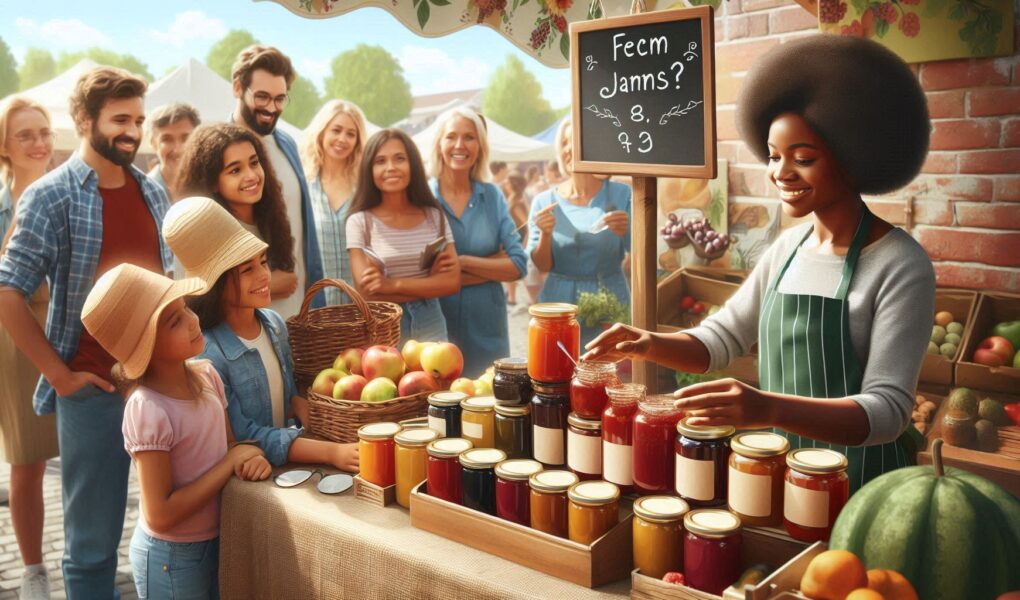It’s been a wild ride, and I’ve learned so much along this farmer’s market journey. If you’re looking to scale your farmer’s market business, I’m here to share the strategies that worked for me.
Let’s turn that $50 into $1500—and beyond.
Start with a Solid Foundation
Before we dive into scaling, let’s talk about the basics. You can’t build a thriving business without a strong foundation. When I started, I focused on three key things: quality, consistency, and branding.
1. Quality is Non-Negotiable
At the farmer’s market, your product is your star. Whether you’re selling fresh produce, baked goods, or handmade crafts, it has to be top-notch. People come to farmer’s markets for something special—something they can’t get at the grocery store.
So, make sure your product stands out. Taste-test your recipes, source the best ingredients, and pay attention to presentation. If your product is exceptional, people will come back for more.
2. Consistency Builds Trust
One of the biggest lessons I learned early on is that consistency matters. Show up every week, rain or shine. Be reliable with your product quality and availability. If you run out of something popular, let your customers know when it’ll be back.
Consistency builds trust, and trust turns one-time buyers into loyal customers.
3. Branding Makes You Memorable
Your booth is your storefront, so make it inviting and reflective of your brand. I started with a simple tablecloth and a handwritten sign, but as I grew, I invested in professional signage, branded packaging, and a cohesive colour scheme. Your branding should tell a story—your story.
Why did you start this business?
What makes your product unique?
Let your personality shine through.
Know Your Numbers
Scaling your business starts with understanding your finances. When I was making $50 a day, I didn’t think much about profit margins or expenses.
But as I grew, I realized that tracking my numbers was crucial to making smart decisions.
1. Calculate Your Costs
Start by figuring out how much it costs to produce your product. Include everything: ingredients, packaging, transportation, and market fees. Once you know your costs, you can set a price that ensures you’re making a profit. Don’t undervalue your work—your time and skill are worth it.
2. Set Sales Goals
When I decided to scale, I set a clear goal: $1000 per market day. To reach that goal, I broke it down into smaller, actionable steps. For example, if I was selling jars of jam for $
10 each, I needed to sell 150 jars. Knowing this helped me plan how much to produce and how to market effectively.
3. Track Your Progress
Keep a record of your sales, expenses, and customer feedback. I use a simple spreadsheet to track my numbers, but there are plenty of apps that can help. Reviewing your data regularly will help you identify trends, adjust your strategy, and stay on track toward your goals.
Expand Your Product Line
One of the easiest ways to increase your sales is to offer more products. When I started, I only sold one flavor of jam. But as I listened to my customers, I realized they wanted variety. Here’s how I expanded my product line without overwhelming myself.
1. Start Small
Introduce one new product at a time. Test it out for a few weeks and see how it sells. If it’s a hit, add it to your regular lineup. If not, tweak the recipe or move on to the next idea. For example, I started with the family recipe, and then created a dipping sauce to go with it.
It was a hit 🙂
2. Bundle Products
Bundling is a great way to increase your average sale. Offer a discount when customers buy multiple items together.
3. Offer Limited Editions
Create a sense of urgency by offering limited-edition products. I’ll never forget the time I introduced a small batch of spicy mango chutney. It sold out in an hour, and customers were begging for more. Limited editions keep things exciting and encourage repeat visits.
Build Relationships with Your Customers
At the farmer’s market, you’re not just selling a product—you’re building a community. The relationships you cultivate with your customers can make or break your business.
1. Engage with Everyone
Smile, make eye contact, and greet everyone who walks by your booth. Even if they don’t buy anything, they’ll remember your friendliness. I’ve had people come back weeks later because they remembered how welcoming I was.
2. Share Your Story
People love knowing the story behind the product. Tell them why you started your business, how you make your product, and what makes it special. I always share a little anecdote about my grandma’s jam recipe, and it never fails to connect with customers.
3. Collect Contact Information
Start building an email list or a social media following. Offer a small discount or freebie in exchange for their email address. This way, you can keep them updated on your products, market schedule, and special promotions.
Leverage Social Media
Social media has been a game-changer for my business. It’s a powerful tool for reaching new customers and staying connected with your existing ones.
1. Show Behind-the-Scenes
People love seeing the process behind your products. Share photos and videos of you making your jam, setting up your booth, or picking fresh ingredients. It adds a personal touch and builds trust.
2. Promote Your Market Schedule
Post your market schedule regularly so your followers know where to find you. I also like to tease new products or special deals to create excitement.
3. Engage with Your Audience
Respond to comments, answer questions, and thank people for their support. Social media is a two-way street, so make it a priority to engage with your audience.
Collaborate with Other Vendors
The farmer’s market is a community, and collaborating with other vendors can benefit everyone. Here are a few ways to work together.
1. Cross-Promote
Partner with other vendors to promote each other’s products. For example, I teamed up with a local baker to offer a “Jam and Bread” combo. We both saw an increase in sales, and our customers loved the convenience.
2. Host Events
Organize special events like live music, cooking demonstrations, or tastings. These events draw more people to the market and create a fun, festive atmosphere.
3. Share Resources
If you’re traveling to multiple markets, consider carpooling or sharing booth space with other vendors. It’s a great way to save money and build relationships.
Think Beyond the Market
While the farmer’s market is a fantastic place to start, don’t limit yourself to just one sales channel. Here’s how I expanded my business beyond the market.
1. Sell Online
Setting up an online store was one of the best decisions I made. It allowed me to reach customers who couldn’t make it to the market. Platforms like Etsy, Shopify, or even Instagram make it easy to sell online.
2. Wholesale Opportunities
Approach local cafes, grocery stores, or gift shops about carrying your products. Wholesale can be a steady source of income and help you reach a wider audience.
3. Offer Workshops
Share your skills by hosting workshops or classes. You could start offering jam-making classes, and they’d probably be a huge hit. It’s another way to diversify your income and connect with your community.
Stay Passionate and Persistent
Scaling your farmer’s market business takes time, effort, and a whole lot of passion. There will be days when sales are slow, or things don’t go as planned. But if you stay persistent and keep learning, you’ll see progress.
I started with just $50 and a dream. Now, I’m consistently hitting $1700 or more at every market (the least that I’ve made at a market is $1700). If I can do it, so can you. Take it one step at a time, celebrate your wins, and don’t be afraid to try new things. Your farmer’s market business has so much potential—go out there and make it happen!
Final Thoughts
Scaling your farmer’s market business from 50to1500 is absolutely possible with the right strategies and mindset. Focus on quality, know your numbers, expand your product line, build relationships, leverage social media, collaborate with others, and think beyond the market. Most importantly, stay passionate and persistent.
You’ve got this!
If you found this post helpful, share it with a fellow vendor or leave a comment below. I’d love to hear about your farmer’s market journey and any tips you’ve picked up along the way.
Happy selling!



